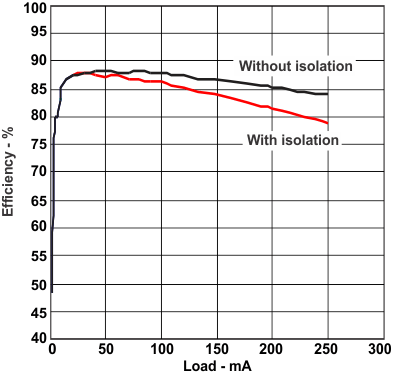JAJS537D September 2009 – April 2019 TPS61093
PRODUCTION DATA.
- 1 特長
- 2 アプリケーション
- 3 概要
- 4 改訂履歴
- 5 Pin Configuration and Functions
- 6 Specifications
- 7 Detailed Description
- 8 Application and Implementation
- 9 Power Supply Recommendations
- 10Layout
- 11デバイスおよびドキュメントのサポート
- 12メカニカル、パッケージ、および注文情報
パッケージ・オプション
メカニカル・データ(パッケージ|ピン)
- DSK|10
サーマルパッド・メカニカル・データ
- DSK|10
発注情報
8.2.1.2.3 Without Isolation FET
The efficiency of the TPS61093 can be improved by connecting the load to the VO pin instead of the OUT pin. The power loss in the isolation FET is then negligible, as shown in Figure 8. The tradeoffs when bypassing the isolation FET are:
- Leakage path between input and output causes the output to be a diode drop below the input voltage when the IC is in shutdown
- No overload circuit protection
When the load is connected to the VO pin, the output capacitor on the VO pin must be above 1 μF.
 Figure 8. Efficiency vs Load
Figure 8. Efficiency vs Load